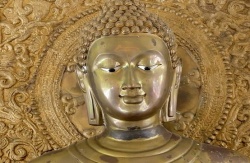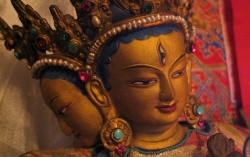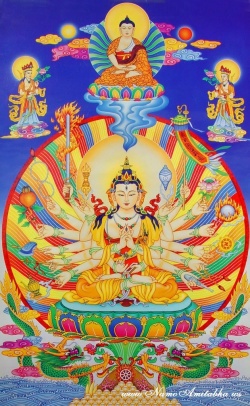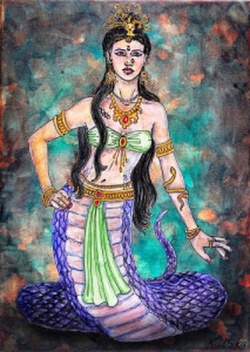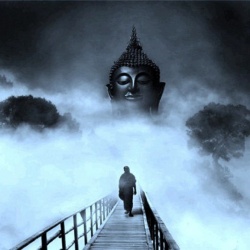Difference between revisions of "Kalachakra What is It?"
m (Text replacement - "]]]" to "]])") |
|||
| Line 27: | Line 27: | ||
The [[Dalai Lama]] says, | The [[Dalai Lama]] says, | ||
| − | "... , unlike any other [[Tantra]], [[Kalachakra]] was [[taught]] at the request of [[Chandrabhadra]], [[King]] of legendary [[Shambhala]], who, for the [[benefit]] of [his [[subjects]] | + | "... , unlike any other [[Tantra]], [[Kalachakra]] was [[taught]] at the request of [[Chandrabhadra]], [[King]] of legendary [[Shambhala]], who, for the [[benefit]] of [his [[subjects]]) traveled to [[India]] and requested such a [[teaching]] from the [[Buddha]]. [[Kalachakra]] therefore has a special relationship to one particular land on this [[earth]]." |
Seven reigns had passed when another [[ruler]], [[Manjushri Ushas]], as [[Shambala]] was being threatened by invasion, composed an Abridged [[Kalachakra Tantra]]. His son, [[Pundarika]], wrote a commentary entitled, [[Stainless Light]]. Those two texts survive, but only fragments remain of the [[Root Tantra]]. | Seven reigns had passed when another [[ruler]], [[Manjushri Ushas]], as [[Shambala]] was being threatened by invasion, composed an Abridged [[Kalachakra Tantra]]. His son, [[Pundarika]], wrote a commentary entitled, [[Stainless Light]]. Those two texts survive, but only fragments remain of the [[Root Tantra]]. | ||
Latest revision as of 04:22, 4 April 2016
Kalachakra is Sanskrit for "Wheel of Time." It is a complete, elaborately detailed, cosmology. It is founded in a tantric cosmogony -- a traditional sacred explanation of the creation and structure of All. In the description, the microcosm that is Man is not different from the macrocosm that is the Universe. Besides these two very complex "maps" -- one outside us, the other inside us, there is given a method -- a way to practice and apply this knowledge, in order to achieve ultimate happiness.
Kalachakra can also be translated, the Cycle of Time. It is the name of a highest level tantra and also the name of the dark blue male deity, whose golden consort is Vishvamata (Mother of the Universe.) The teaching of it, which is preparatory to the initiation, requires the construction of an intricate mandala, and to do it is an extensive undertaking.
Tantric Buddhism traces its origins to Buddha Sakyamuni's fourth "Turning of the Wheel," which is believed to have occurred at the stupa of Sri Dhanakosha near Amravali in Andhra Pradesh, India, in the year of His Enlightenment. All the high tantras such as Chakrasamvara, Guhyasamaya, and Kalachakra, derive from this.
The time of this transmission is variously given, though. For,
"According to one interpretation, the Kalachakra Tantra was first spoken by the Teacher Sakyamuni Buddha, at the time of the full moon in the third month of the year after his having shown the manner of becoming completely and perfectly enlightened. According to another interpretation, Sakyamuni, having showed the manner of becoming completely and perfectly enlightened, turned the three wheels of doctrine, and then one year before his passing away set forth the Kalachakra Tantra."
How does the Kalachakra fit into the Buddhist system?
The First Turning of the Wheel was at Sarnath, in the king's deer park. This was Shakyamuni Buddha's Discourse on the Four Noble Truths ("the truth of suffering ...") that he gave particularly to the five companions with whom he had been practicing various austerities. It forms the motivation or basis for all Buddhists.
The Second Turning of the Wheel took place at Vulture Peak outside Gaya and includes the discourse on compassion and Emptiness. It is exemplified by the Prajnaparamita literature -- a condensed form is the Heart (Skt : hridya) Sutra: "Form is Emptiness; Emptiness [is] Form." All Mahayana Buddhists have this teaching as the basis for their consideration of other beings.
The Third Turning of the Wheel was at Vaishali and some other places. It comprises the elucidation of "Emptiness" and its relation to Buddha Nature. The Mahaparanirvana Sutra and such Mahayana commentaries as the Uttaratantra Shastra address this. Not all Mahayana Buddhists have the same view of these texts.
History
According to Alexander Berzin, the system as taught by the Dalai Lama has three sources:
First, Buddha Shakyamuni taught it to an Indian audience that included the ruler of Shambhala. He, with his entourage of 96 others, returned home to set down what they had heard in The Root Kalachakra Tantra.
The Dalai Lama says,
"... , unlike any other Tantra, Kalachakra was taught at the request of Chandrabhadra, King of legendary Shambhala, who, for the benefit of [his subjects) traveled to India and requested such a teaching from the Buddha. Kalachakra therefore has a special relationship to one particular land on this earth."
Seven reigns had passed when another ruler, Manjushri Ushas, as Shambala was being threatened by invasion, composed an Abridged Kalachakra Tantra. His son, Pundarika, wrote a commentary entitled, Stainless Light. Those two texts survive, but only fragments remain of the Root Tantra.
The Kalachakra teachings eventually reached India in the tenth century, brought by two masters who, although they had tried to reach the mysterious land did not succeed. They had visionary experiences of the system, however, and were able to record those. Naturally there were some discrepancies and consequently, four styles of Kalachakra practice evolved that differ in minor detail.
Those two versions may account for some differences in historic details, such as the King of Shambhala's name (also given as Suchandra.) Both names are also epithets for the Indian god, Shiva, whose many titles include chandra, Sanskrit for moon.
In the 11th century, the Kalachakra was brought to central Tibet by three different masters. Parts of the system also eventually made it north. The Tibetans made at least three different translations, and so there exist a number of variations. Today it is not possible to say which, if any of these, is the "correct" version, nor even the exact way of applying the practice. However, on the whole, the system is internally consistent as "about eighty percent of the material is shared in common."
On the origins, and transmission of this tantra to Tibet.
In the 17th century, the Kalachakra made it to Inner Mongolia and Beijing, the Manchu capital of China, and on to Amdo, the northeastern province of Tibet. In the 19th century, the system reached western (or, Outer) Mongolia and the Buryiat territory around Lake Baikal, Siberia.
By the early 20th century, it had reached Tuva in Turkestan and Kalmykia, the Mongolian region of European Russia. In 1915, the system had made a great enough impact that the Czar commissioned a Kalachakra temple for St. Petersburg.
Ling Rinpoche was the Dalai Lama's tutor and is the source of his transmission. It came down through Buston Rinchen Drupa (1290-1364) who combined two Tibetan translations with commentary. One was by Ra Dorje Drukpa and the other, by Dro Sherab Drak. The R[w]a lineage is via Naropa.
World Peace
Surprisingly, some people see in the Dalai Lama's desire to pass on the Kalachakra vision, a kind of conspiracy to undermine other cultural or religious commitments. His Holiness does not claim that the Kalachakra is the one and only, superior and perfect practice for all people. Nor has he ever said that performing the initiation will automatically bring harmony to this complex world, although it may improve the condition for peace to flourish. Furthermore, he has always discouraged people from switching from one religion to another, and points out that the benefits of studying Buddha-dharma and doing certain practices can benefit people of all faiths. It has never been said that it is necessary to abandons one's native religion in order to become a Buddhist.
The Shambhala legend has it that political and religious discord was healed by the Kalachakra vision and practice, but no one would claim that it is the "only way to go." Furthermore, not all the Dalai Lamas have taken it up. The contemporary (the 14th) holder of that title enjoys doing it, teaching it and passing it on. People of all walks of life are welcome to attend for whatever reason -- out of curiosity, for educational reasons, from personal conviction, to support the projects of His Holiness or out of devotion to him.
What is a Monlam ?
Besides the widely publicized Kalachakra, the various Tibetan Buddhist denominations hold special prayer meetings (monlam) that also attract thousands of people. For example, in late 2002 and 2003, the Kagyu Monlam Chenmo took place near the spot of Buddha's Enlightenment. A Gelug Monlam was held at the maidan (parade ground) followed by a Kalachakra ritual teaching.
In 2003, the Nyingma order gathered for their annual Monlam Chenmo together in Bodhgaya from Feb. 2nd-12th, 2003. The Sakya chose Lumbini, Nepal, the birthplace of the Buddha for theirs, about the same date.
Many members of other religious groups attend these monlams for the purpose of experiencing the darshan of the Lamas.
happiness: This is the ultimate objective of all Buddhist practice, bearing in mind that we view existence as very long indeed -- transcending many lifetimes in various states and conditions according to Karma.
Turning of the Wheel: The Buddha's distinctive presentations of his doctrine are referred to in this way.
darshan: blessing of the presence of a holy being or relic.
Some References
Tenzin Gyatso (The 14th Dalai Lama.) World of Tibetan Buddhism. Wisdom, 1995.
Tenzin Gyatso. Kalachakra Tantra: Rite of Initiation. Wisdom Publ., 1985.
